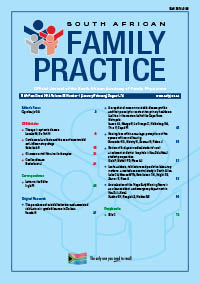Coeliac disease
Keywords:
coeliac disease, autoimmune enterophathy, ingestion, gluten-containing cereals
Abstract
Coeliac disease is an autoimmune enteropathy triggered by the ingestion of gluten-containing cereals, such as wheat, rye and barley. It is estimated to occur in one per cent of people of European ancestry, and in 0.3% of black Africans. Coeliac disease has a strong genetic component as nearly all patients with the disease share the same genetic predisposition in the form of the presence of either the human leukocyte antigen (HLA)-DQ2 or HLA-DQ8 alleles. The spectrum of symptoms ranges from asymptomatic to chronic diarrhoea, flatulence, abdominal pain and weight loss. Although serological testing for tissue transglutaminase antibodies is both sensitive and specific for the disease, and reflects disease activity, small bowel biopsy is considered to be the standard when diagnosing the disease. The therapy for coeliac disease is a gluten-free diet, which may be difficult and expensive to follow. Nonadherence to a gluten-free diet is the main cause of persistent or recurrent symptoms. Coeliac disease increases the risk of malignancies, such as small bowel adenocarcinoma and enteropathy-associated T-cell lymphoma; pathologies which should be excluded in patients who are compliant with the diet but who are either persistently symptomatic or have a reoccurrence of symptoms. Because coeliac disease is an important cause of common gastrointestinal symptoms and may have significant long-term complications if left untreated, it is paramount that the family practitioner should consider it in the differential diagnosis of patients who present with suspected symptoms. The perception of coeliac disease has changed in recent years from an uncommon enteropathy to a common multisystem disease with a strong genetic predisposition.
Published
2013-11-13
Section
CPD
By submitting manuscripts to SAFP, authors of original articles are assigning copyright to the South African Academy of Family Physicians. Copyright of review articles are assigned to the Publisher, Medpharm Publications (Pty) Ltd, unless otherwise specified. Authors may use their own work after publication without written permission, provided they acknowledge the original source. Individuals and academic institutions may freely copy and distribute articles published in SAFP for educational and research purposes without obtaining permission.

